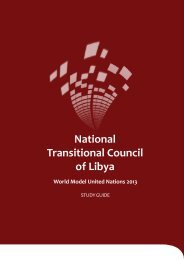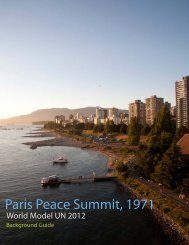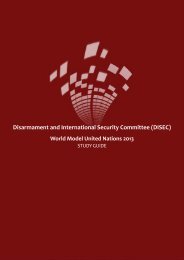Social, Humanitarian and Cultural Committee (SOCHUM)
Social, Humanitarian and Cultural Committee (SOCHUM)
Social, Humanitarian and Cultural Committee (SOCHUM)
Create successful ePaper yourself
Turn your PDF publications into a flip-book with our unique Google optimized e-Paper software.
The vast majority of languages have fewer than 100,000 speakers, which puts them at risk for extinction.<br />
is about one-sixth of the estimated number of<br />
languages in existence at the beginning of European<br />
settlement. uruguay has no indigenous languages<br />
left, as the entire native population has either been<br />
driven out or integrated into the white majority. 53<br />
Africa provides another interesting case for the<br />
study of endangered languages. While the continent<br />
encompasses about two thous<strong>and</strong>, or 30%, of the<br />
world’s languages, 54 only about two hundred of<br />
these languages are in danger of extinction. this low<br />
number, relative to those of the other continents, is<br />
due primarily to the fact that the dominant european<br />
languages have not spread as extensively throughout<br />
Africa as they have through the rest of the world. Still,<br />
the causes of language endangerment still operate<br />
in Africa, just on a smaller scale. Minority language<br />
communities are slowly ab<strong>and</strong>oning their mother<br />
tongues, especially in the countries with high numbers<br />
of languages, such as Nigeria, Cameroon, <strong>and</strong> the<br />
Democratic Republic of the Congo (over two hundred<br />
languages each), not for the internationally dominant<br />
European languages but for the local dominant native<br />
languages. 55 Because much of the economy of most<br />
African countries is still fairly regional, this process is<br />
moving more slowly than in many other parts of the<br />
world, but language endangerment is nevertheless<br />
still a problem in Africa. 56<br />
The region hit the hardest by language<br />
endangerment in recent years has been Asia <strong>and</strong> the<br />
Pacific. Asian countries contain over two thous<strong>and</strong><br />
languages, about one-third of the world’s total; the<br />
Pacific region is not far behind with about thirteen<br />
hundred, or 19% of the world’s languages. 57 the<br />
high number of languages in Asia <strong>and</strong> the Pacific<br />
means that many of them have a small population of<br />
speakers, which makes them especially susceptible<br />
to language endangerment. One country that<br />
exemplifies this problem is Papua New Guinea. With<br />
eight hundred languages, Papua New Guinea is home<br />
to more languages than any other nation in the world.<br />
Linguists cite the long period of settlement in the area,<br />
the isolated terrain due to mountains <strong>and</strong> isl<strong>and</strong>s,<br />
<strong>and</strong> the historical lack of centralized government as<br />
reasons for the multitude of languages in Papua New<br />
Guinea. Most of the languages of Papua New Guinea,<br />
however, have fewer than one thous<strong>and</strong> speakers,<br />
the vast majority of whom are usually centered<br />
around a single village. Some of these languages have<br />
19<br />
Melbourne Host Directorate PTY LTD | Office of Media <strong>and</strong> Design

















